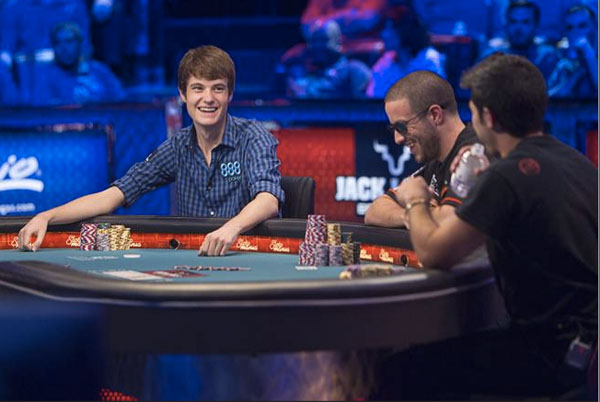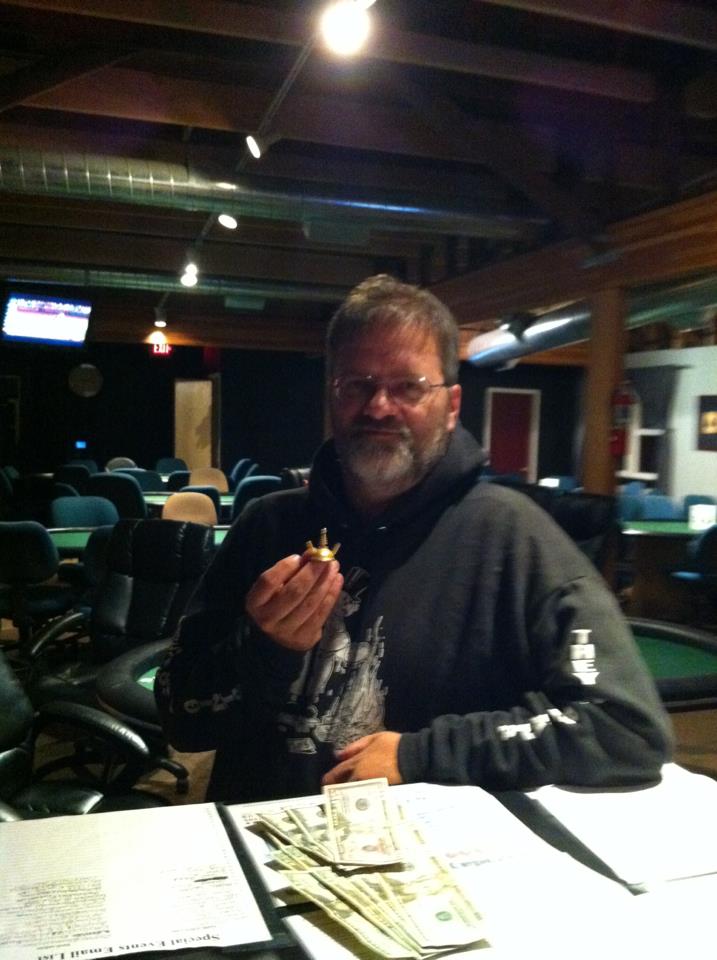
Jake Balsiger (left), at the 2012 WSOP Main Event with Greg Merson (center) and Jesse Sylvia. Photo via Hockgepokert.
The final table of the 2012 Main Event is over and despite coming close, Jake Balsiger didn’t manage to get out of last place three-handed long enough to shrink that ever-narrowing gap between eligibility to play in Las Vegas casinos and Joe Cada’s current standing as the youngest winner of the big title. One of the talking points about Balsiger was that—although he graduated from high school and attends college in Phoenix, Arizona—he’s a native of Portland.
Naturally, that got me wondering about how the rest of the state’s contingent of poker players did during this year’s WSOP. I turned once again to the dueling WSOP databases of wsopdb.com and the QuadJacks WSOP database (and, of course, the official WSOP site) for some unpaid, self-entertaining research. (An aside, this would be a lot faster if I could get access to the databases themselves instead of having to collate and cross-check incomplete data from multiple front-end sources, but my efforts seem to get lost in the noise.) Bear in mind that all of the results I’m working with are my best effort, not absolute reality; the databases have omissions and errors, but I’ve done my best to correct invalid information I’ve run across. Due to the limitations of the data collected by the WSOP itself, I’ve focused only on Oregon and haven’t included the Clark County portion of the Portland metro area. Sorry, Vancouverites, if you want stats from across the Columbia, you’re going to have to crank them yourself (or pay me).
What Did We Play?
By my count, there were 303 individuals from Oregon who entered WSOP ring events this year. We entered every bracelet event except for:
- #7 ($1,500 Seven-Card Stud)
- #10 ($5,000 Seven-Card Stud)
- #17 (Pot-Limit Hold’em)
- #22 (2-7 Triple Draw Lowball)
- #32 ($10,000 H.O.R.S.E.)
- #34 ($5,000 Pot-Limit Omaha / Six-Handed)
- #37 ($2,500 Eight-Game Mix)
- #39 ($10,000 Pot-Limit Omaha)
- #42 ($2,500 Omaha/Seven-Card Stud Hi-Low 8 or Better)
- #45 ($50,000 The Poker Players Championship)
- #55 ($1,000,000 The Big One for One Drop — No-Limit Hold’em)
- #60 ($10,000 2-7 Draw Lowball)
That’s 49 of the 61 bracelet events, which includes #1 ($560 Casino Employees No-Limit Hold’em) getting 3 Oregon entries. Apparently, Oregon players don’t much care for 2-7 Lowball games (though I played a brief game of Triple Draw at Encore one evening with JB and SG and had a good time although I bubbled) or million-dollar buy-ins.
The event that drew the largest number of Oregonians was #29 ($1,000 Seniors No-Limit Hold’em Championship), with 53 entries in a field of 4,128 (1.28%). Yet that wasn’t the highest participation rate. The seniors event this year was enormous—the largest single starting day for a tournament in poker history—and even half-century worth of aging Oregonians didn’t quite match the percentages who came for #43 ($1,500 No-Limit Hold’em) which got 37 entries and #44 ($1,000 No-Limit Hold’em) which got 40, for 1.34% and 1.36% of the field, respectively.
Oregon poker players stepped up to 1.5% of the field in #51 ($1,000 Ladies No-Limit Hold-em Championship). 14 of 936 entries was outmatched only by the seven players who jumped into #35 (Mixed Hold’em, Limit/No-Limit) to pump the O up to 1.78% of the field. Sadly, only 12 of the entrants were actually women, with a couple of serious WSOP players adding the Ladies event to their list of 10+ entries. I was there during the tournament and when the subject of guys playing the event came up—as it did a number of times—not a single person elicited any sympathy for the idea of men playing in the women’s tournament. I’m not naming names, but you know who you are, Cody and Steve. So the number of actual Oregon women in the Ladies event was only 12.8%.
The lowest rate of participation (that wasn’t 0%) was 0.21% for the single Oregon player who entered #57 (No-Limit Hold’em / Six Handed). Median participation rate in events with Oregon entries (where half the events are higher and half are lower) was 0.78%. Main Event participation was 41 of 6,598 entries: 0.62%.
217 of the Oregon players played just a single WSOP bracelet event. Ten played only the Main Event. Most of the single-entries were in regular $1,000 buy-in events or the similarly-priced Seniors and Ladies events (the 3 entrants to the Casino Employees event only needed to pay $560) but a number of singletons (60) chose to punch a little higher into the $1,500 bracket (including H.O.R.S.E. and NLHE 6-Max games), and a handful of others went up to $2,500 or $3,000 for their big shots.
69 players entered between 2 and 5 bracelet events. Only 8 held the middle ground between 6 and 10 events. Ten Oregonians played between 11 and 19 WSOP bracelet events in 2012.
How Did We Do?
Sad to say, the facts of poker are such that only a small number of players make the money and even fewer make a profit. The good news is, 59 of the 303 Oregon players I found in the databases cashed at least once during the WSOP this year. That’s 19.5%. Those players accounted for 81 cashes out of a total 627 entries, meaning that the ITM rate of the group was 12.9%. That’s relatively in line with the 13.2% average ITM I calculated for 2011 WSOP final tableists back before this year’s events began (and it’s better than a random distribution of 10% payout structures).
24 of the single-entry players cashed. At 11.1% that’s lower than the state contingent as a whole, but the good thing is that each of those players has a positive ROI—even if it’s small in some cases—for their ride on the WSOP wheel. Because the grim truth is—as I pointed out in the June analysis—many of the pros who buy in to multiple events have a negative return on their WSOP investment even when they cash. The 2011 final table sample group had a 41% negative cash flow rate among players who entered 10 or more tournaments and cashed at least once. For Oregon players in 2012, 39 of the 59 cashing players had a profit at the end of the series (33% had negative ROI), but if you remove the two dozen single-entry players, the numbers are 15 profitable players among 35 players who cashed. 57% of that group showed a loss for the series. Looking at just the players with 10 or more entries: 4 profits in 11 cashing players (64% losing).
Is There An Upside?
One Oregon player got a real bang for his thousand bucks this year. A player from Bonanza—near Klamath Falls—entered #59 ($1,000 No-Limit Hold’em) just before the beginning of the Main Event and made it to 6th place in a field of 4,620 for a payday of $120,748. Five other single-entry players made profits between $5,000 and $16,000. The others were all profits of $3,500 or less.
Only one of the 22 cashing players with 2 to 8 entries made more than $10,000 in profit. Alexander Beck of Happy Valley cashed twice in six events—including nearly $33,000 for a 372nd-place finish in the Main Event—ending the series with more than $21,500 in profit. 49 of the players with 2 to 8 entries didn’t cash. 12 of the 22 cashing players lost between $76 and $20,000.
Two Oregonians with 9 or more entries were the bright lights of the hard-core poker players this year.
Greg Hobson took first in #49 (Ante-Only No-Limit Hold’em), winning the bracelet and $256,691 (and, combined with former Portlander Jeffrey Dobrin’s WSOP Circuit ring win back in January, making the city a powerhouse of ante-only, for whatever that’s worth). It was Hobson’s only cash in ten entries. Hobson’s entry illustrates one of the issues with tracking information on poker players, the official WSOP entry list for the event says he’s from Portland, which is also what’s on all of his other entry forms for both 2011 and 2012, but the official final report says Alaska.
Jamie Robbins, also from Oregon?, was the most visible player from the state, making it to the last three tables of the Main Event, and busting in 19th place for $294,601. Robbins’s entry sheets say Portland, a 2009 interview with Card Player says San Diego, and ESPN’s coverage of Robbins’s madman bluff of Stephen Gee has him living in Lake Tahoe. Ironically (from an Oregon connection standpoint), Jake Balsiger was the player who knocked him out. He’s a power player who finished 11th at the Main Event in 2009. A $6,142 cash in #36 ($3,000 Pot-Limit Omaha) is logged to Portland, the Main Event cash is logged to Lake Tahoe, California.
Robbins and Hobson are the only Oregon players who played more than one event with six-figure profits. 15 players entered 9 or more events. All but one of them (a player with 13 entries) cashed at least once. Only four other players from the group were profitable, however, by amounts of $497, $3,851, $26,294, and $26,552. The other players with nine or more entries who cashed (and the one who didn’t) ended the series with losses between around $1,500 and $38,500.
What’s It All Mean?
Beats me. Even with 19.5% of the players cashing, the average profit for Oregon players at the WSOP this year was a meagre $3,177. Most players who entered more than one event and cashed still lost money. Poker is a harsh mistress, maybe?
I’m headed to Pendleton for the Wildhorse Fall Poker Round-Up this weekend and next, after winning a seat to the Main Event there at the wonderful Portland Players Club. Let the cards fall where they may….

